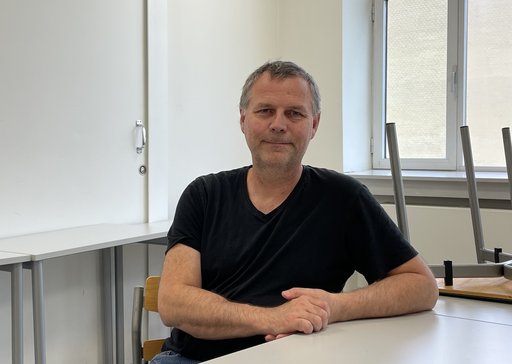Become a pilot for classrooms of the future
Eight classrooms at Health have been technically upgraded to so-called 'HyFlex' rooms. You can sign up as a pilot if you are a teacher and would like to work with flexible hybrid teaching of the future in which students participate both onsite and online simultaneously.

Facts
There is a total of eight HyFlex rooms at Health.
The e-moderators are students who have been trained by the CED.
Around 50 students have been trained to help with Zoom teaching.
Each room can accommodate approx. 30 students onsite
The eight HyFlex rooms are:
- Building 1150 - room 115
- Building 1231 - room 214
- Building 1613 - room 49
- Building 1613 - room 109
- Building 1631 - room 135
- Building 3410 - room 318
- Building 3410 - room 518
- Building 1231 - room 318
It may not look like much. A couple of cameras in the corners and some microphones hanging from the ceiling. But if you step into room 214 in building 1231, you take a small step into the future. The cameras in the corners and the microphones hanging from the ceiling ensure high-quality teaching both for students in the room and for students on Zoom.
The room is one of eight HyFlex classrooms which have been upgraded at Health by HE IT Support in collaboration with the Centre for Educational Development (CED). Now we just need teachers to use the rooms as intended, says Mads Ronald Dahl, a special consultant at the CED:
"It's state-of-the-art technology, and now we're trying to develop a form of didactics around it. The pilots can be teaching staff whose classes have already been divided due to lack of space in the laboratories. The teaching sessions can be practical, where students work hands-on with their subject. For instance, training molecular structures in a database, or trying to understand the 3D structure of insulin,” he explains.
An e-moderator zooms in and out
The advantage of HyFlex rooms is that cameras and microphones give online students the full teaching experience. Without the extra equipment, it can be difficult to hear when fellow students in the room ask questions, or it can be difficult to see properly when the teacher demonstrates a practical example. All pilots will be assigned an e-moderator who controls the buttons, so they can focus fully on their teaching.

With technology in place, focus should be on planning the teaching, so that both students in the room and on Zoom are activated, says Mads Ronald Dahl:
"You have to stick to the teaching plan, and also make sure that students are the ones performing and not the teacher. So, the teacher's role is primarily to initiate activities or assignments that can be solved by students both onsite and online."
Teachers should therefore allocate some extra time for planning hybrid teaching.
"It's kind of like if you have to plan your teaching for the first time. You need to allocate a few extra hours, so that everyone gets the most out of the HyFlex rooms. And it’s also important that the teachers are tech savvy. Even though there’s an e-moderator, they need to know the basics such as BrightSpace, Zoom and PowerPoint," says Mads Ronald Dahl.
The HyFlex rooms are intended as a supplement to the teaching that is already taking place at the faculty. Therefore, there is no need for developing new courses, and the teachers do not have to plan all lessons according to hybrid teaching. The hope is that the pilots will plan at least two 45-minute sessions of hybrid teaching in their normal teaching.
From Aarhus to Emdrup – and from AU to the living room
Associate Professor Niels Trolle teaches biostatistics at the Department of Public Health. He has run a teaching course in which students participated onsite in Aarhus and online in Emdrup. He did not have access to the HyFlex rooms, and poor sound and a stationary camera did cause problems, he says.
"The cameras were in a fixed position, so the students in Emdrup could see what I wrote on the board. There were two screens in Emdrup. One for PowerPoint and one for streaming. In principle, there was also sound back and forth. But if I turned up the volume too much, the noise went from one room to the other. So, it was a challenge."
Despite the challenges, the possibility of hybrid teaching was a good solution to a logistical problem with students in two different places. And when the moment of truth came in the form of exams, there was no difference between the results of the students online from Emdrup and the students onsite in Aarhus.
HyFlex rooms provide an opportunity to improve a joint teaching session between campus in Aarhus and students in Emdrup or Foulum, for example" says Mads Ronald Dahl from the CED. And if teachers can see where it makes sense and exploit this technology, the potential is great, he says.
"With little effort, research-based teaching and internationalisation can be expanded even more with visiting lecturers, collaboration partners and industry, for example. This teaching format can meet the need for flexibility, and it can be used for specialised modules aimed at experts, PhD students, Circle U. courses, or for teaching staff on professional Master's programmes where students are at a different stage in life."